Solar light-Driven photocatalyst-enzyme attached artificial photosynthetic system for regeneration and production of 1,4-NADH and L-glutamate
In artificial photosynthesis process the photocatalyst-enzyme attached system is a best strategy to utilize solar
energy for solar chemical/fuels production. Herein, we prepared a solar light active graphene-based photocatalyst
received by the covalent attachment of 9-aminoanthracene (AA) chromophore with chemically converted graphene
(CCG) for highly efficient 1,4-NADH regeneration (79.9 %) and conversion of α-ketoglutarate (α-KG) in to Lglutamate (L-GM) (88.3 %) in 2 hrs. The present result is a benchmark example of highly selective solar light active
enzyme based artificial photosynthetic system for selective formation of L-GM from α-KG.
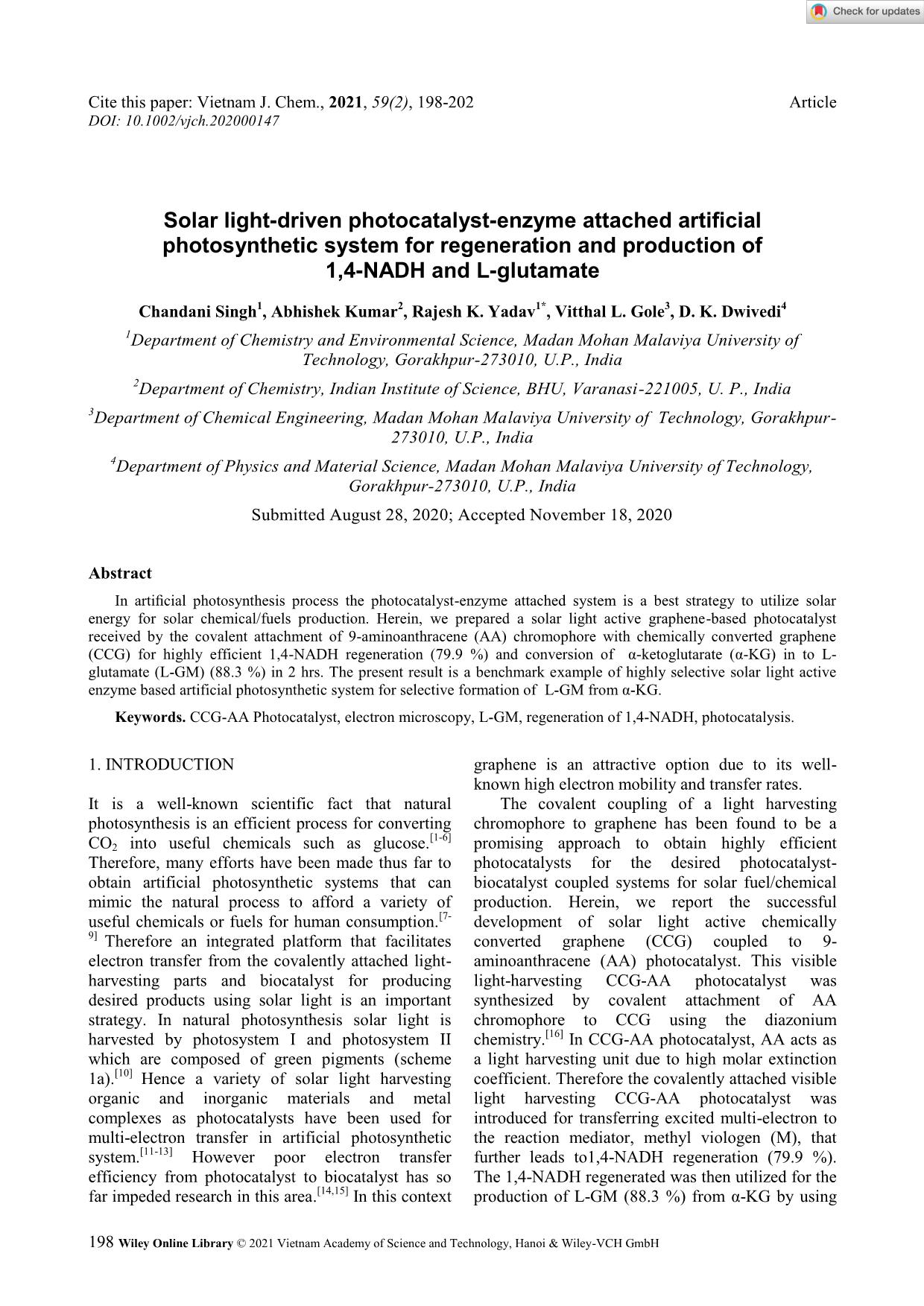
Trang 1

Trang 2
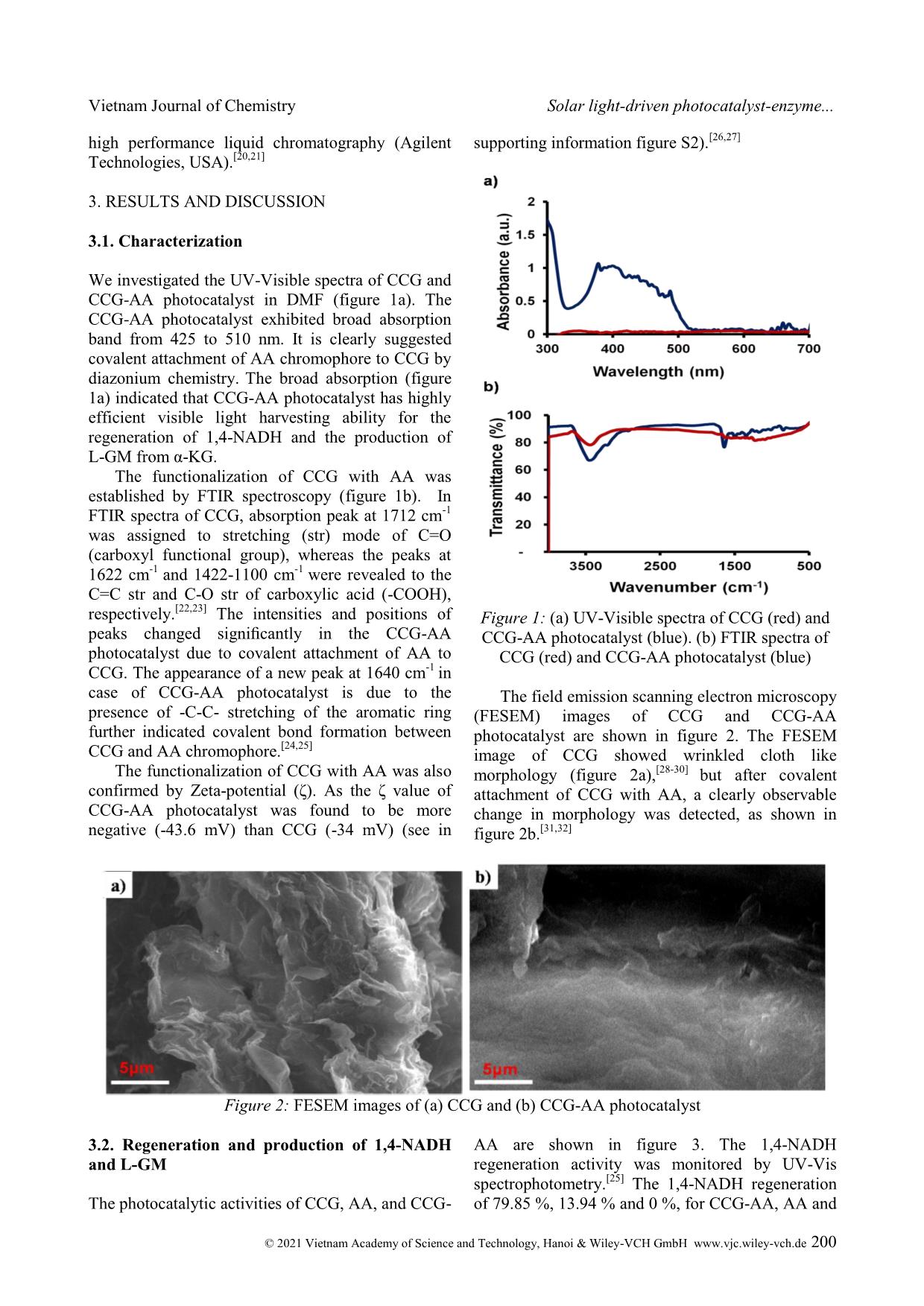
Trang 3
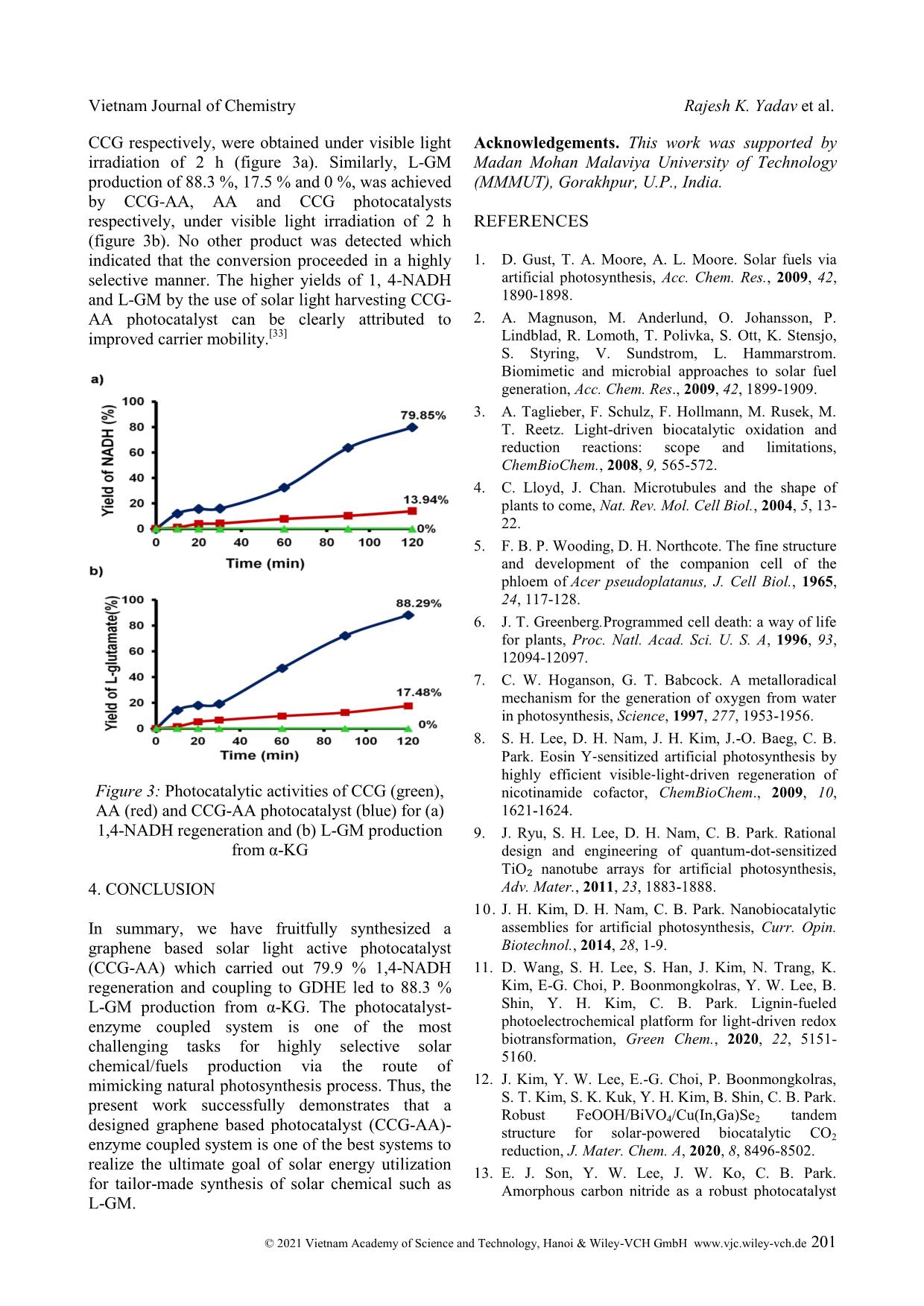
Trang 4
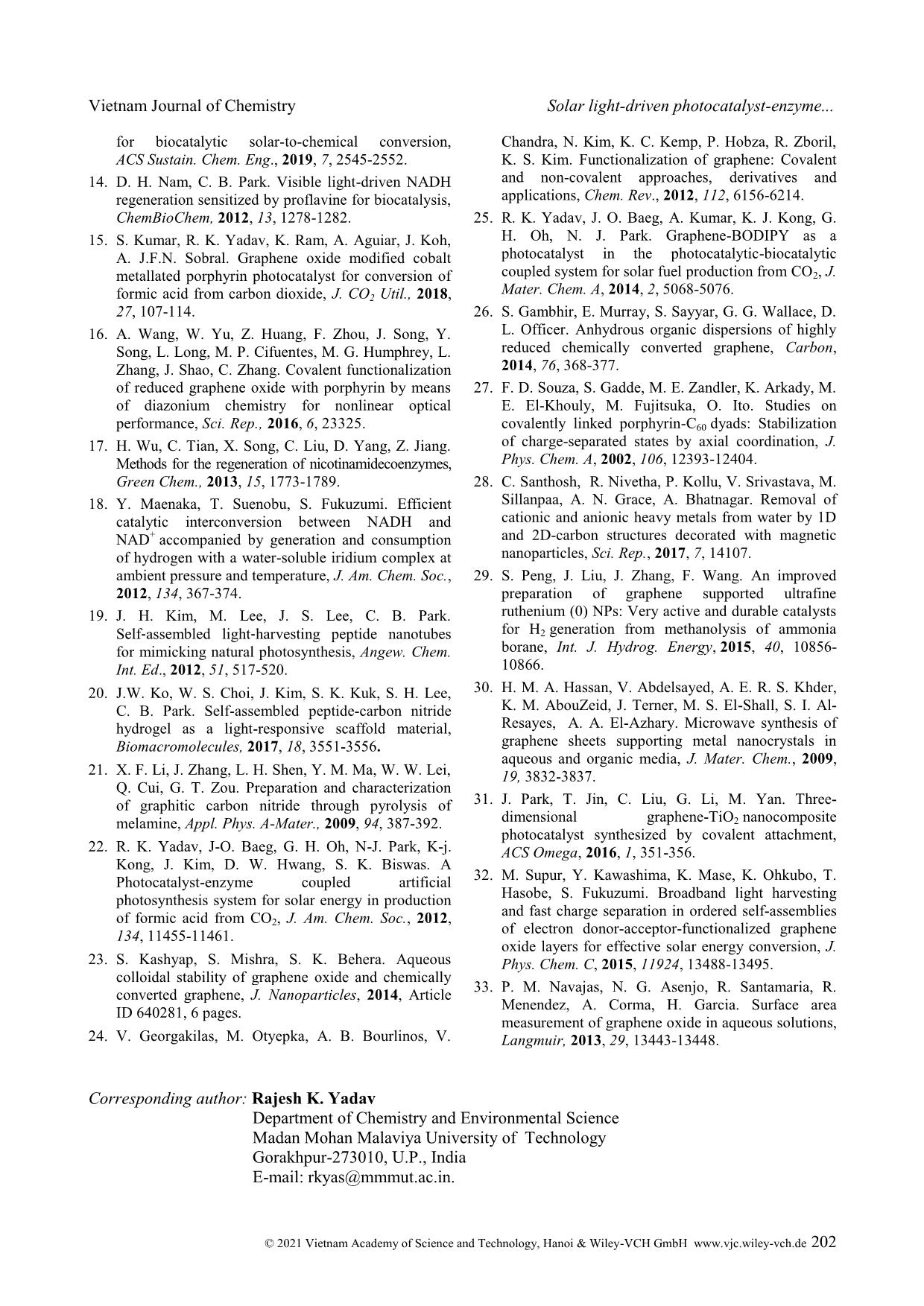
Trang 5
Bạn đang xem tài liệu "Solar light-Driven photocatalyst-enzyme attached artificial photosynthetic system for regeneration and production of 1,4-NADH and L-glutamate", để tải tài liệu gốc về máy hãy click vào nút Download ở trên
Tóm tắt nội dung tài liệu: Solar light-Driven photocatalyst-enzyme attached artificial photosynthetic system for regeneration and production of 1,4-NADH and L-glutamate
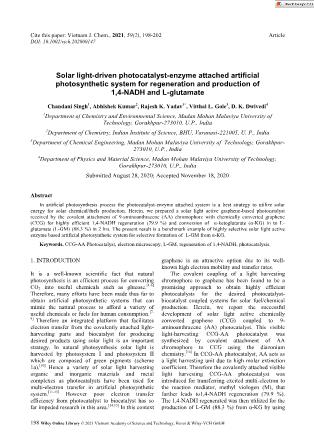
Cite this paper: Vietnam J. Chem., 2021, 59(2), 198-202 Article DOI: 10.1002/vjch.202000147 198 Wiley Online Library © 2021 Vietnam Academy of Science and Technology, Hanoi & Wiley-VCH GmbH Solar light-driven photocatalyst-enzyme attached artificial photosynthetic system for regeneration and production of 1,4-NADH and L-glutamate Chandani Singh 1 , Abhishek Kumar 2 , Rajesh K. Yadav 1* , Vitthal L. Gole 3 , D. K. Dwivedi 4 1 Department of Chemistry and Environmental Science, Madan Mohan Malaviya University of Technology, Gorakhpur-273010, U.P., India 2 Department of Chemistry, Indian Institute of Science, BHU, Varanasi-221005, U. P., India 3 Department of Chemical Engineering, Madan Mohan Malaviya University of Technology, Gorakhpur- 273010, U.P., India 4 Department of Physics and Material Science, Madan Mohan Malaviya University of Technology, Gorakhpur-273010, U.P., India Submitted August 28, 2020; Accepted November 18, 2020 Abstract In artificial photosynthesis process the photocatalyst-enzyme attached system is a best strategy to utilize solar energy for solar chemical/fuels production. Herein, we prepared a solar light active graphene-based photocatalyst received by the covalent attachment of 9-aminoanthracene (AA) chromophore with chemically converted graphene (CCG) for highly efficient 1,4-NADH regeneration (79.9 %) and conversion of α-ketoglutarate (α-KG) in to L- glutamate (L-GM) (88.3 %) in 2 hrs. The present result is a benchmark example of highly selective solar light active enzyme based artificial photosynthetic system for selective formation of L-GM from α-KG. Keywords. CCG-AA Photocatalyst, electron microscopy, L-GM, regeneration of 1,4-NADH, photocatalysis. 1. INTRODUCTION It is a well-known scientific fact that natural photosynthesis is an efficient process for converting CO2 into useful chemicals such as glucose. [1-6] Therefore, many efforts have been made thus far to obtain artificial photosynthetic systems that can mimic the natural process to afford a variety of useful chemicals or fuels for human consumption. [7- 9] Therefore an integrated platform that facilitates electron transfer from the covalently attached light- harvesting parts and biocatalyst for producing desired products using solar light is an important strategy. In natural photosynthesis solar light is harvested by photosystem I and photosystem II which are composed of green pigments (scheme 1a). [10] Hence a variety of solar light harvesting organic and inorganic materials and metal complexes as photocatalysts have been used for multi-electron transfer in artificial photosynthetic system. [11-13] However poor electron transfer efficiency from photocatalyst to biocatalyst has so far impeded research in this area. [14,15] In this context graphene is an attractive option due to its well- known high electron mobility and transfer rates. The covalent coupling of a light harvesting chromophore to graphene has been found to be a promising approach to obtain highly efficient photocatalysts for the desired photocatalyst- biocatalyst coupled systems for solar fuel/chemical production. Herein, we report the successful development of solar light active chemically converted graphene (CCG) coupled to 9- aminoanthracene (AA) photocatalyst. This visible light-harvesting CCG-AA photocatalyst was synthesized by covalent attachment of AA chromophore to CCG using the diazonium chemistry. [16] In CCG-AA photocatalyst, AA acts as a light harvesting unit due to high molar extinction coefficient. Therefore the covalently attached visible light harvesting CCG-AA photocatalyst was introduced for transferring excited multi-electron to the reaction mediator, methyl viologen (M), that further leads to1,4-NADH regeneration (79.9 %). The 1,4-NADH regenerated was then utilized for the production of L-GM (88.3 %) from α-KG by using Vietnam Journal of Chemistry Rajesh K. Yadav et al. © 2021 Vietnam Academy of Science and Technology, Hanoi & Wiley-VCH GmbH www.vjc.wiley-vch.de 199 glutamate dehydrogenase enzyme (GDHE). Scheme 1b represents the photocatalyst-enzyme attached artificial photosynthetic system involved in the solar chemicals production such as L-GM under the irradiation of solar light. The solar light harvesting AA (electron donor) transfers electron to CCG (acceptor). [17] The CCG then transfers electrons efficiently to reduce M. Upon reduction, M transfered proton and electrons for the reduction of NAD + to 1,4-NADH cofactor. In this manner, M acts as a reaction mediator between CCG-AA photocatalyst and NAD + . Finally, the electrons and protons of 1,4-NADH are used for the exclusive production of L-GM with the help of GDHE. Scheme 1: Schematic representation of (a) natural photosynthesis which includes many electron mediator for the production of glucose and oxygen (b) artificial photosynthetic system using CCG-AA photocatalyst for carrying out L-GM production from α-KG 2. MATERIALS AND METHODS 2.1. Synthesis of CCG-AA photocatalyst The CCG-AA photocatalyst was synthesized by reported litrature method (see in supporting information figure S1). [16] 250 mL distilled water solution of CCG (1 g) was prepared in 1L round- bottom flask (RB). The suspension was ultrasonicated for 1 h, 5 mL hydrazine hydrate (50 %) was added and using ammonia solution to maintain pH upto 11. The resultant mixture was stirred at 90 o C for 1 h. Subsequently, AA (2.34 g) and isoamyl nitrite (3 mL) were added, the mixture was stirred vigorously overnight at 80 o C and then cooled down to room temperature. The solution was filtered through a membrane filter paper (0.2 mm). The resultant CCG-AA cake was washed with distilled water and dil. HCl until a clear solution was obtained. The resultant black solid material was dried under vacuum oven to receive CCG-AA in 80 % yield. 2.2. Photochemical 1,4-NADH regeneration Solar light driven artificial photosynthetic system for 1,4-NADH regeneration was executed in a quartz reactor at ambient temperature by using 450W halogen lamp (artificial light source) equipped with cut-off filter (420 nm). In the above reactor 0.7 mg CCG-AA photocatalyst, 0.62 μmol methyl viologen (M), 1.24 μmol NAD+ and 1.24 mmol AsA were dispersed in buffer solution (2.3 ml, pH 7.0). The 1,4-NADH regeneration was monitored at 340 nm by UV-Visible spectrophotometer. [18,19] 2.3. Solar light responsive artificial photosynthesis of L-GM from α-KG The production of L-GM from α-KG also carried out in quartz reactor in presence of 450W halogen lamp (artificial light source) along with cut-off filter (420 nm) under solar light irradiation at ambient temperature. For synthesis of L-GM, reaction solution was prepared by using 0.7 mg CCG-AA, 0.62 μmol M, 1.24 μmol NAD+, 30 units GDH, α-10 mmol ketoglutarate, 100 mM (NH4)2SO4 and 1.24 mmol AsA dispersed in buffer solution (2.3 ml, pH 7.0). The yield of L-GM was carried out by using Vietnam Journal of Chemistry Solar light-driven photocatalyst-enzyme... © 2021 Vietnam Academy of Science and Technology, Hanoi & Wiley-VCH GmbH www.vjc.wiley-vch.de 200 high performance liquid chromatography (Agilent Technologies, USA). [20,21] 3. RESULTS AND DISCUSSION 3.1. Characterization We investigated the UV-Visible spectra of CCG and CCG-AA photocatalyst in DMF (figure 1a). The CCG-AA photocatalyst exhibited broad absorption band from 425 to 510 nm. It is clearly suggested covalent attachment of AA chromophore to CCG by diazonium chemistry. The broad absorption (figure 1a) indicated that CCG-AA photocatalyst has highly efficient visible light harvesting ability for the regeneration of 1,4-NADH and the production of L-GM from α-KG. The functionalization of CCG with AA was established by FTIR spectroscopy (figure 1b). In FTIR spectra of CCG, absorption peak at 1712 cm -1 was assigned to stretching (str) mode of C=O (carboxyl functional group), whereas the peaks at 1622 cm -1 and 1422-1100 cm -1 were revealed to the C=C str and C-O str of carboxylic acid (-COOH), respectively. [22,23] The intensities and positions of peaks changed significantly in the CCG-AA photocatalyst due to covalent attachment of AA to CCG. The appearance of a new peak at 1640 cm -1 in case of CCG-AA photocatalyst is due to the presence of -C-C- stretching of the aromatic ring further indicated covalent bond formation between CCG and AA chromophore. [24,25] The functionalization of CCG with AA was also confirmed by Zeta-potential (ζ). As the ζ value of CCG-AA photocatalyst was found to be more negative (-43.6 mV) than CCG (-34 mV) (see in supporting information figure S2). [26,27] Figure 1: (a) UV-Visible spectra of CCG (red) and CCG-AA photocatalyst (blue). (b) FTIR spectra of CCG (red) and CCG-AA photocatalyst (blue) The field emission scanning electron microscopy (FESEM) images of CCG and CCG-AA photocatalyst are shown in figure 2. The FESEM image of CCG showed wrinkled cloth like morphology (figure 2a), [28-30] but after covalent attachment of CCG with AA, a clearly observable change in morphology was detected, as shown in figure 2b. [31,32] Figure 2: FESEM images of (a) CCG and (b) CCG-AA photocatalyst 3.2. Regeneration and production of 1,4-NADH and L-GM The photocatalytic activities of CCG, AA, and CCG- AA are shown in figure 3. The 1,4-NADH regeneration activity was monitored by UV-Vis spectrophotometry. [25] The 1,4-NADH regeneration of 79.85 %, 13.94 % and 0 %, for CCG-AA, AA and Vietnam Journal of Chemistry Rajesh K. Yadav et al. © 2021 Vietnam Academy of Science and Technology, Hanoi & Wiley-VCH GmbH www.vjc.wiley-vch.de 201 CCG respectively, were obtained under visible light irradiation of 2 h (figure 3a). Similarly, L-GM production of 88.3 %, 17.5 % and 0 %, was achieved by CCG-AA, AA and CCG photocatalysts respectively, under visible light irradiation of 2 h (figure 3b). No other product was detected which indicated that the conversion proceeded in a highly selective manner. The higher yields of 1, 4-NADH and L-GM by the use of solar light harvesting CCG- AA photocatalyst can be clearly attributed to improved carrier mobility. [33] Figure 3: Photocatalytic activities of CCG (green), AA (red) and CCG-AA photocatalyst (blue) for (a) 1,4-NADH regeneration and (b) L-GM production from α-KG 4. CONCLUSION In summary, we have fruitfully synthesized a graphene based solar light active photocatalyst (CCG-AA) which carried out 79.9 % 1,4-NADH regeneration and coupling to GDHE led to 88.3 % L-GM production from α-KG. The photocatalyst- enzyme coupled system is one of the most challenging tasks for highly selective solar chemical/fuels production via the route of mimicking natural photosynthesis process. Thus, the present work successfully demonstrates that a designed graphene based photocatalyst (CCG-AA)- enzyme coupled system is one of the best systems to realize the ultimate goal of solar energy utilization for tailor-made synthesis of solar chemical such as L-GM. Acknowledgements. This work was supported by Madan Mohan Malaviya University of Technology (MMMUT), Gorakhpur, U.P., India. REFERENCES 1. D. Gust, T. A. Moore, A. L. Moore. Solar fuels via artificial photosynthesis, Acc. Chem. Res., 2009, 42, 1890-1898. 2. A. Magnuson, M. Anderlund, O. Johansson, P. Lindblad, R. Lomoth, T. Polivka, S. Ott, K. Stensjo, S. Styring, V. Sundstrom, L. Hammarstrom. Biomimetic and microbial approaches to solar fuel generation, Acc. Chem. Res., 2009, 42, 1899-1909. 3. A. Taglieber, F. Schulz, F. Hollmann, M. Rusek, M. T. Reetz. Light-driven biocatalytic oxidation and reduction reactions: scope and limitations, ChemBioChem., 2008, 9, 565-572. 4. C. Lloyd, J. Chan. Microtubules and the shape of plants to come, Nat. Rev. Mol. Cell Biol., 2004, 5, 13- 22. 5. F. B. P. Wooding, D. H. Northcote. The fine structure and development of the companion cell of the phloem of Acer pseudoplatanus, J. Cell Biol., 1965, 24, 117-128. 6. J. T. Greenberg.Programmed cell death: a way of life for plants, Proc. Natl. Acad. Sci. U. S. A, 1996, 93, 12094-12097. 7. C. W. Hoganson, G. T. Babcock. A metalloradical mechanism for the generation of oxygen from water in photosynthesis, Science, 1997, 277, 1953-1956. 8. S. H. Lee, D. H. Nam, J. H. Kim, J.-O. Baeg, C. B. Park. Eosin Y‐sensitized artificial photosynthesis by highly efficient visible‐light‐driven regeneration of nicotinamide cofactor, ChemBioChem., 2009, 10, 1621-1624. 9. J. Ryu, S. H. Lee, D. H. Nam, C. B. Park. Rational design and engineering of quantum-dot-sensitized TiO₂ nanotube arrays for artificial photosynthesis, Adv. Mater., 2011, 23, 1883-1888. 10. J. H. Kim, D. H. Nam, C. B. Park. Nanobiocatalytic assemblies for artificial photosynthesis, Curr. Opin. Biotechnol., 2014, 28, 1-9. 11. D. Wang, S. H. Lee, S. Han, J. Kim, N. Trang, K. Kim, E-G. Choi, P. Boonmongkolras, Y. W. Lee, B. Shin, Y. H. Kim, C. B. Park. Lignin-fueled photoelectrochemical platform for light-driven redox biotransformation, Green Chem., 2020, 22, 5151- 5160. 12. J. Kim, Y. W. Lee, E.-G. Choi, P. Boonmongkolras, S. T. Kim, S. K. Kuk, Y. H. Kim, B. Shin, C. B. Park. Robust FeOOH/BiVO4/Cu(In,Ga)Se2 tandem structure for solar-powered biocatalytic CO2 reduction, J. Mater. Chem. A, 2020, 8, 8496-8502. 13. E. J. Son, Y. W. Lee, J. W. Ko, C. B. Park. Amorphous carbon nitride as a robust photocatalyst Vietnam Journal of Chemistry Solar light-driven photocatalyst-enzyme... © 2021 Vietnam Academy of Science and Technology, Hanoi & Wiley-VCH GmbH www.vjc.wiley-vch.de 202 for biocatalytic solar-to-chemical conversion, ACS Sustain. Chem. Eng., 2019, 7, 2545-2552. 14. D. H. Nam, C. B. Park. Visible light-driven NADH regeneration sensitized by proflavine for biocatalysis, ChemBioChem, 2012, 13, 1278-1282. 15. S. Kumar, R. K. Yadav, K. Ram, A. Aguiar, J. Koh, A. J.F.N. Sobral. Graphene oxide modified cobalt metallated porphyrin photocatalyst for conversion of formic acid from carbon dioxide, J. CO2 Util., 2018, 27, 107-114. 16. A. Wang, W. Yu, Z. Huang, F. Zhou, J. Song, Y. Song, L. Long, M. P. Cifuentes, M. G. Humphrey, L. Zhang, J. Shao, C. Zhang. Covalent functionalization of reduced graphene oxide with porphyrin by means of diazonium chemistry for nonlinear optical performance, Sci. Rep., 2016, 6, 23325. 17. H. Wu, C. Tian, X. Song, C. Liu, D. Yang, Z. Jiang. Methods for the regeneration of nicotinamidecoenzymes, Green Chem., 2013, 15, 1773-1789. 18. Y. Maenaka, T. Suenobu, S. Fukuzumi. Efficient catalytic interconversion between NADH and NAD + accompanied by generation and consumption of hydrogen with a water-soluble iridium complex at ambient pressure and temperature, J. Am. Chem. Soc., 2012, 134, 367-374. 19. J. H. Kim, M. Lee, J. S. Lee, C. B. Park. Self‐assembled light‐harvesting peptide nanotubes for mimicking natural photosynthesis, Angew. Chem. Int. Ed., 2012, 51, 517-520. 20. J.W. Ko, W. S. Choi, J. Kim, S. K. Kuk, S. H. Lee, C. B. Park. Self-assembled peptide-carbon nitride hydrogel as a light-responsive scaffold material, Biomacromolecules, 2017, 18, 3551-3556. 21. X. F. Li, J. Zhang, L. H. Shen, Y. M. Ma, W. W. Lei, Q. Cui, G. T. Zou. Preparation and characterization of graphitic carbon nitride through pyrolysis of melamine, Appl. Phys. A-Mater., 2009, 94, 387-392. 22. R. K. Yadav, J-O. Baeg, G. H. Oh, N-J. Park, K-j. Kong, J. Kim, D. W. Hwang, S. K. Biswas. A Photocatalyst-enzyme coupled artificial photosynthesis system for solar energy in production of formic acid from CO2, J. Am. Chem. Soc., 2012, 134, 11455-11461. 23. S. Kashyap, S. Mishra, S. K. Behera. Aqueous colloidal stability of graphene oxide and chemically converted graphene, J. Nanoparticles, 2014, Article ID 640281, 6 pages. 24. V. Georgakilas, M. Otyepka, A. B. Bourlinos, V. Chandra, N. Kim, K. C. Kemp, P. Hobza, R. Zboril, K. S. Kim. Functionalization of graphene: Covalent and non-covalent approaches, derivatives and applications, Chem. Rev., 2012, 112, 6156-6214. 25. R. K. Yadav, J. O. Baeg, A. Kumar, K. J. Kong, G. H. Oh, N. J. Park. Graphene-BODIPY as a photocatalyst in the photocatalytic-biocatalytic coupled system for solar fuel production from CO2, J. Mater. Chem. A, 2014, 2, 5068-5076. 26. S. Gambhir, E. Murray, S. Sayyar, G. G. Wallace, D. L. Officer. Anhydrous organic dispersions of highly reduced chemically converted graphene, Carbon, 2014, 76, 368-377. 27. F. D. Souza, S. Gadde, M. E. Zandler, K. Arkady, M. E. El-Khouly, M. Fujitsuka, O. Ito. Studies on covalently linked porphyrin-C60 dyads: Stabilization of charge-separated states by axial coordination, J. Phys. Chem. A, 2002, 106, 12393-12404. 28. C. Santhosh, R. Nivetha, P. Kollu, V. Srivastava, M. Sillanpaa, A. N. Grace, A. Bhatnagar. Removal of cationic and anionic heavy metals from water by 1D and 2D-carbon structures decorated with magnetic nanoparticles, Sci. Rep., 2017, 7, 14107. 29. S. Peng, J. Liu, J. Zhang, F. Wang. An improved preparation of graphene supported ultrafine ruthenium (0) NPs: Very active and durable catalysts for H2 generation from methanolysis of ammonia borane, Int. J. Hydrog. Energy, 2015, 40, 10856- 10866. 30. H. M. A. Hassan, V. Abdelsayed, A. E. R. S. Khder, K. M. AbouZeid, J. Terner, M. S. El-Shall, S. I. Al- Resayes, A. A. El-Azhary. Microwave synthesis of graphene sheets supporting metal nanocrystals in aqueous and organic media, J. Mater. Chem., 2009, 19, 3832-3837. 31. J. Park, T. Jin, C. Liu, G. Li, M. Yan. Three- dimensional graphene-TiO2 nanocomposite photocatalyst synthesized by covalent attachment, ACS Omega, 2016, 1, 351-356. 32. M. Supur, Y. Kawashima, K. Mase, K. Ohkubo, T. Hasobe, S. Fukuzumi. Broadband light harvesting and fast charge separation in ordered self-assemblies of electron donor-acceptor-functionalized graphene oxide layers for effective solar energy conversion, J. Phys. Chem. C, 2015, 11924, 13488-13495. 33. P. M. Navajas, N. G. Asenjo, R. Santamaria, R. Menendez, A. Corma, H. Garcia. Surface area measurement of graphene oxide in aqueous solutions, Langmuir, 2013, 29, 13443-13448. Corresponding author: Rajesh K. Yadav Department of Chemistry and Environmental Science Madan Mohan Malaviya University of Technology Gorakhpur-273010, U.P., India E-mail: rkyas@mmmut.ac.in.
File đính kèm:
 solar_light_driven_photocatalyst_enzyme_attached_artificial.pdf
solar_light_driven_photocatalyst_enzyme_attached_artificial.pdf

